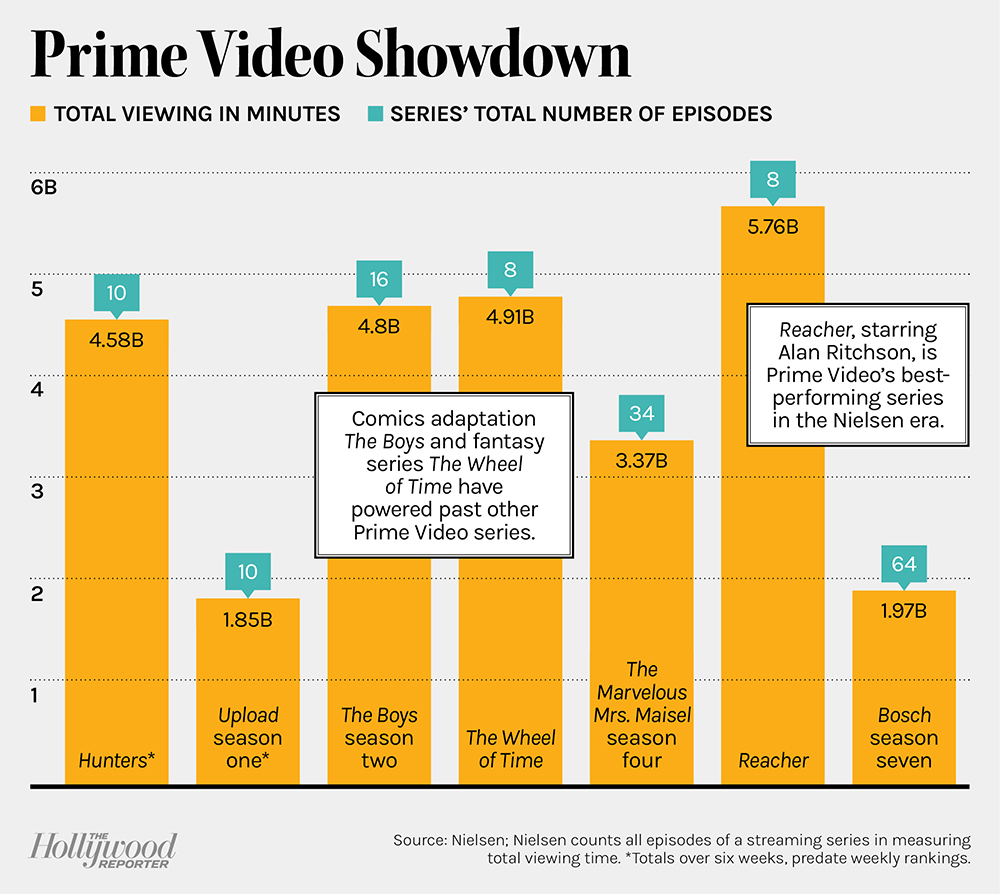
Source: Nielsen

Amazon was among the early players in the streaming landscape, with its first original series debuting in 2013, a couple of months after Netflix’s House of Cards. In the intervening nine years, however, it would not be easy to discern a cohesive strategy behind the programming on the tech giant’s Prime Video streaming service. Prime Video doesn’t have near the volume of programming that Netflix does, nor is it as franchise-driven as streamers attached to legacy studios (and their troves of IP) are. But where it doesn’t have a decades-long string of movie and TV titles it owns on which to draw, the company has turned to its roots as an online bookseller to adapt a number of best-selling novels as series.
In fact, Prime Video’s three biggest original series in the past two-plus years, as measured by Nielsen — Reacher, The Wheel of Time and The Boys (season two) — are based on books. Shows like Bosch, which ended its seven-season run on Prime in 2021, and Jack Ryan also have best-sellers as their source material.
And of course, Amazon Studios, led by Jennifer Salke, has placed a huge bet on a series based on one of the best-known novels of the past century: J.R.R. Tolkien’s The Lord of the Rings. That series, The Lord of the Rings: The Rings of Power, is scheduled to premiere in September. One possibly encouraging sign for the very expensive Rings of Power: the numbers for Wheel of Time. The first season delivered about 4.9 billion minutes of viewing time in the U.S. over the course of its run in late 2021 (and a couple weeks after, when it lingered in Nielsen’s top 10 streaming originals rankings).
Meanwhile, Reacher, based on the Lee Child novels, is Prime Video’s best-performing series in the era of Nielsen streaming rankings, tallying 5.76 billion minutes of viewing during six weeks in the ratings service’s top 10. It also had the best debut week of any Prime Video series, with 1.84 billion minutes from Jan. 31 to Feb. 6. Season two of The Boys — whose source material is Garth Ennis and Darick Robertson’s comic book — racked up 4.8 billion minutes over six weeks, coming in just behind The Wheel of Time. (Amazon says the recently debuted season three had a better premiere than season two in 2020, though as is usually the case with streamers, it didn’t provide much supporting data.)
Just behind those three is the platform’s best-performing show not based on preexisting IP, the Nazi thriller Hunters. The show premiered in February 2020 and racked up 4.58 billion minutes of viewing over its first six weeks of release (the show predates Nielsen’s weekly streaming rankings by several months).
Emmy darling The Marvelous Mrs. Maisel comes in a bit behind those four. The show’s fourth season debuted in February and had a little less than 3.4 billion minutes of watch time during a seven-week run in the top 10. Upload is Prime Video’s only half-hour comedy to break into the Nielsen top 10 in the past two years; its first season in May 2020 had 1.85 billion minutes of viewing over six weeks, but season two in April spent only two weeks on the chart, grabbing 800 million minutes of viewing in that time. (All series, obviously, continue to be watched after exiting the top 10, but lacking more extensive data, they can’t be quantified.)
Prime Video’s top-performing series of the past couple of years showcase an eclectic mix of tones and styles — and also a variety of release strategies. The platform isn’t beholden to any single pattern. Reacher, Hunters and both seasons of Upload have followed the binge model, releasing entire seasons at once. The Boys and The Wheel of Time premiered with three episodes, then rolled out the remainder of their seasons weekly. Following all-at-once premieres for its first three seasons, The Marvelous Mrs. Maisel switched to debuting two episodes per week for four weeks — a pattern copied by Prime’s Josh Brolin-led supernatural Western Outer Range (1.72 billion minutes during its time in the top 10).
The variety of release patterns suggest there’s not a one-size-fits-all approach to finding success in streaming — a fact borne out by other platforms as well. Netflix is steadfast in adhering to its binge model (for scripted series, at least), while Disney+’s Marvel and Star Wars shows can sustain solid tune-in with weekly episode premieres.
The Rings of Power will follow a weekly release when it premieres in September. Amazon is likely betting that the anticipation for the series will be strong enough to keep viewers coming back week after week. It’s an expensive bet — The Rings of Power is among the most costly series ever mounted. There’s evidence in the shows Prime Video has rolled out in the past two years, however, that it can work.

Source: Nielsen
This story first appeared in the June 15 issue of The Hollywood Reporter magazine. Click here to subscribe.